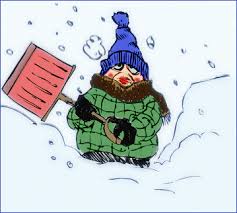By Lisa Denison, Creation Care Ministry member
Most of us do what we do because, well, we’ve always done it that way. We learned when we were young; no need to reinvent the wheel. Nothing could be more routine for Michiganders than snow removal. No need to rethink that one, right? Creation Care’s Lisa Denison has been pondering that snow removal question. Read her recommendations to see whether your habits need a refresh!
 Sooner or later we will be dealing with this… so be ready with these earth-friendly snow and ice removal tips!
Sooner or later we will be dealing with this… so be ready with these earth-friendly snow and ice removal tips!
The number-one earth-friendly method: shoveling. You can’t beat shoveling for getting exercise and fresh air (as long as your health allows it). Maybe you know some kids stuck at home who would welcome earning some money? I can see you rolling your eyes, so keep reading….
How to prevent slips and falls on ice
The best products for traction only are sand, bird seed, and non-clumping kitty litter. For both traction and ice melting, try alfalfa meal!
Alfalfa meal is a highly effective ice melting substance and is 100-percent natural! It does contain nitrogen, which is what makes it an effective fertilizer, but it contains this element in lesser concentrations, making it less of a threat to local water systems when used in moderation. Because it’s dry and grainy, alfalfa meal has the added benefit of creating additional traction while it’s working on melting the ice. Bags of alfalfa meal can be purchased at most gardening stores or online.
If you are still inclined to buy an “ice-melt” product, read the ingredients, not the claims. If there isn’t an ingredient list on the package, don’t buy it! Note that “pet friendly” is not necessarily the same as “environment friendly.”
When you’re checking that ingredient list, avoid sodium chloride, the worst of all the salts, environmentally speaking. The least harmful chemical option is calcium chloride. It melts ice faster (almost instantly!) than other options and at a lower temperature point (-20°F). It can be a cost-effective option since one ounce of calcium chloride can melt twice the amount of ice as one ounce of magnesium chloride.
Using calcium chloride ice melts can have negative effects.
- It can be harmful to pets! Always clean your pet’s feet after exposure to ice melts to prevent irritation or burns.
- Can corrode metals, causing damage to your car.
- Overapplication of calcium chloride ice melts can lead to plant damage.
- Calcium chloride can damage concrete, especially when the concrete is less than a year old. It’s generally considered, though, to be less damaging than other ice melts.
- It tracked indoors, calcium chloride can leave an oily residue that’s difficult to remove.
Minimize the negative effects of using ice melts
Use only the recommended amount of ice melts and consider using a mechanical spreader to coat surfaces as evenly as possible. The longer an ice melt sits on a surface, the more damage can occur. Reduce potential damage by scooping up the salty slush and disposing of it. When you move it, though, be careful not to shovel it onto your lawn; you’ll prevent damage to vegetation. Apply ice melt only when necessary and remove the slush once it’s done its job to reduce the potential for damage.
Use caution when applying ice melts; wear protective gloves and eyewear. Ice melts are chemical compounds that can cause skin irritations or burns.
And don’t attempt to use ice melts to remove ice from your roof!
